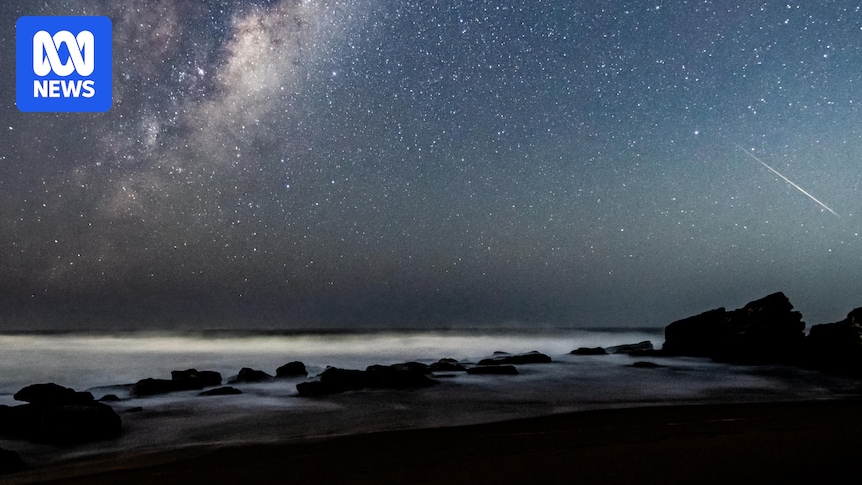This week is a great time to find somewhere dark and look up with the annual Orionid meteor shower gracing southern skies.
The Orionids streak across the sky every October as Earth passes through the debris trail left behind Halley’s Comet.
At their peak early this week on October 21 and 22 the Orionids may produce up to 17 meteors each hour in perfect conditions. Weather and light pollution permitting, these should be fairly easy to see anywhere across Australia.
If you don’t get to see the Orionids peak, there will still be a few meteors to see later this week, as long as you know when to look.
“If you’re out camping at that time and you’re up later in the night, they’re worth a look,” Jonti Horner, an astronomer at the University of Southern Queensland, says.
“Relax under the stars and just see what you see.”
What day is best to see the Orionids?
The Orionid meteor shower has already started, with meteors visible from the start of October until November 7.
But the best time to see them will be the early morning of Tuesday, October 21.
This is the peak of meteor shower, when the Earth passes through the “thickest” part of the debris trail and the most meteors will be visible.
This year, the Orionids also coincide with a new moon, meaning the sky will be darker than during other times of the lunar cycle.
How many meteors will I see?
Those in dark sky conditions, away from light pollution, in northern Australia may be able to see up to 17 meteors an hour in very dark skies, according to Professor Horner.
Those in southern Australia might see closer to 12 an hour.
While you might see some websites suggesting much higher numbers, this is extremely unlikely for actual viewing conditions in Australia, even under perfect conditions.
Most viewing conditions are not ideal, and it’s worth keeping in mind your location and cloud cover when estimating how many meteors you might actually see.
What time will I see the most meteors?
The Orionid meteor shower, like most major meteor showers, is best seen in the early hours of the morning.
This is because the spot in the sky where meteors will appear to come from, called the “radiant point”, rises about midnight wherever you are in Australia.
All meteor showers have a radiant point, where the meteors seem to radiate from. (Wikimedia: Geminidák meteorraj maximuma/Berkó Ernő/CC BY-SA 3.0)
But you’ll get a better view if you wait a bit later when the radiant point is higher, with the best view “around 4am or 5am if you have daylight savings”, Professor Horner says.
The radiant point of the Orionids should be visible until close to sunrise around all of Australia.
Numbers of meteors per hour are usually calculated from the “zenithal hourly rate”, which is the maximum number of meteors expected to be seen if the radiant point is directly above your head under perfect conditions.
You’ll see more meteors the further north you are because the point will be further above the horizon at its highest (but it will never be directly above your head).
How to best see the Orionid meteor shower
To see the meteor shower, find somewhere dark and look north-east after midnight.
You’ll need to let your eyes adjust to the darkness — so definitely no peeking at your phone!
After a few minutes, find Orion’s belt, also known as the saucepan.
Then look slightly towards the horizon. Below the belt is Orion’s shoulder star, called Betelgeuse, one of the brightest stars in the sky.
The meteor shower’s radiant point is just below Betelgeuse.
Meteors will be visible below Orion’s belt in the early morning of 21 October. (Credit: Stellarium/ABC Science)
Once you’ve found the right spot to look, wait.
Professor Horner explained that although there might be an average of around 10 meteors an hour, they do not come uniformly.
“It’s not one every six minutes,” he says.
“[You might have to] wait 25 minutes, and then you see two or three in the next few minutes.”
What causes the Orionids?
Meteors, sometimes called shooting stars, are produced when specks of space dust and debris, no bigger that the size of a grain of sand, enter and burn up in Earth’s atmosphere.
Comets, meteors and meteorites are commonly confused. (ABC Science: Kelly Wong)
While meteors happen all year round, there are many more during meteor showers, when the Earth passes through areas of space with more debris in it.
The Orionids are one of two meteor showers caused by Halley’s comet, which drops a trail of dust and gas as it travels through space.
In October each year, Earth’s path around the Sun intersects with that dust trail, producing the Orionids.
This same debris trail is crossed again by Earth in May, which causes the Eta Aquariid meteor shower.
Most meteor showers are caused by Earth moving through debris from comets, but one meteor shower is caused by debris from an asteroid.
The Geminid meteor shower is caused by the debris from an asteroid known as 3200 Phaethon.
Halley’s Comet intersects with Earth twice in a year to cause both the Eta Aquariid and the Orionid meteor showers. (Supplied: NASA/SSD/edited by ABC Science)
When will the next meteor shower happen?
If you miss out on the Orionids, Professor Horner says the Geminid meteor shower, which happens in December, is worth waiting for.
“The Geminids are the best shower of the year,” he says.
The meteor shower peaks in the early morning of December 14.

